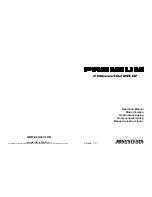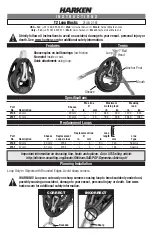
MAINTENANCE PROCEDURES
5
COLD WATER BASIN AND BASIN STRAINERS
The cold water basin should be inspected regularly. Any debris
which may have accumulated in the basin or on the strainers should
be removed. Quarterly, or more often if necessary, the entire cold
water basin should be drained, cleaned and flushed with fresh water
to remove the silt and sediment which normally collects in the basin
and under the wet deck surface during operation.
When flushing the basin, the strainers should be left in place to
prevent the sediment from re-entering the unit system. After the
basin has been flushed, the strainers should be removed, cleaned,
and replaced before refilling the basin with fresh water.
!
DO NOT USE ACID TO CLEAN THE STRAINERS
OPERATING LEVEL AND MAKE-UP
Operating height is the water level above sump bottom during
operation.
1. Operating height
2. Overflow
3. Pan Bottom
Operating heights for the evaporative cooling equipment are
indicated in the tables below :
To check the operating level, proceed as follows :
1. Shut off fan(s) but keep pump(s) running.
2. Remove circular access door next to make-up connection.
3. Measure height from sump bottom to water level and compare
with face value from table.
4. Check valve for leakage and replace valve seat, if necessary.
5. Check that float arm can move freely and that float ball floats
and closes valve.
6. Ensure that make-up water supply is adequate.
Note: This procedure does not apply for
- equipment equipped with electrical water level control
- remote sump applications
If a float operated water make-up is used, initial setting and regular
adjustments are needed.
The float controlling the make-up valve is mounted on a threaded
rod, held in place by wing nuts. (see figure below)
1. Float Ball
2. All Threaded Rod
3. Wing Nuts
4. Float Arm Assembly
5. Float Valve
To make the initial setting, adjust the wing nuts so that the valve is
completely closed when the water level in the cold water sump is 13
mm below the overflow level. Under normal load conditions this
setting should produce the correct operating level. At low load
conditions the operating level will raise and need be adjusted.
BLOW DOWN
In case of a continuous blow down with a metering valve in the
bleed line, ensure that the valve is unobstructed and that blow down
water can drain freely. Measure the blow down flow rate by
recording the time needed to fill a given volume.
For automatic blow down using conductivity control, ensure that the
conductivity probe is clean and that the blow down solenoid valve is
operational. Unless you have a specific adjustment procedure, your
water treatment company should check and adjust set points.
SUMP HEATER PACKAGE
Sump heaters must only operate in the winter to prevent the sump
water from freezing, when the water pump(s) and the fan(s) are shut
off. Under no circumstances should sump heaters operate at other
times as they could potentially heat the water to temperature levels,
which are favourable to bacteriological growth. Ensure every six
months the heater thermostat is properly set and clean. Also ensure
that control and safety devices, such as low level cut out switches,
are operational, clean and properly incorporated into the control
circuit.
BELT TENSIONING
Belt tensioning can be adjusted by changing the position of the fan
motor(s) by rotating the motor base adjustment screw, which
extends through the bottom frame angel. Check belt tension as
follows :
1. Shut off fan(s) .
2. Rotate the fan sheave half a turn to evenly distribute the tension
in the belt before measuring.
3. Check belt tension
Checks and Adjustments
Model
Operating Height
(measured from pan bottom)
(mm)
VTL
140
VCL
140
VFL
140
Table 2: Operating Heights
Figure 1: Operating Water Level
Figure 2: Water Make-up Valve Assembly


































